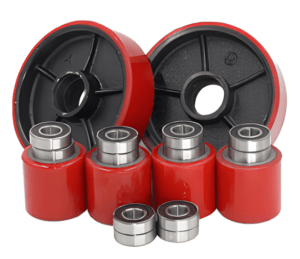Materials of Excellence
Crafting with the Best in the Business
At Julong Rubber, we prioritize using the finest materials to ensure the durability, efficiency, and performance of every product. Explore the various high-quality materials that form the foundation of our premium rubber components.
Polyurethane Rubber
The Versatile Powerhouse of Resilience
Polyurethane rubber, abbreviated as PU, boasts a remarkable balance between toughness and elasticity. Its unique composition offers an impressive blend of the flexibility seen in rubber and the durability of plastic. This means it can absorb impact yet resist wear and tear, making it indispensable in applications demanding resilience against abrasion and stress.

Polyurethane Rubber:Applications,and How to Choose
Polyurethane rubber (PU) is a highly versatile material widely used in industrial applications due to its superior mechanical properties, chemical resistance, and durability. This comprehensive guide explores the properties, applications, and selection criteria for polyurethane rubber—designed specifically for B2B procurement officers looking for reliable industrial solutions.
What is Polyurethane Rubber?
Polyurethane rubber is a type of elastomer made from a combination of polyols and isocyanates, resulting in a material that offers the flexibility of rubber with the toughness of plastic. It bridges the gap between rubber and plastic materials in terms of performance and durability.
Is polyurethane a rubber or plastic?
Polyurethane is an elastomer that can exhibit properties of both rubber and plastic depending on its formulation. It is often classified as a rubber because of its flexibility and elasticity, but it can also be engineered to behave like a rigid plastic.
What Are the Advantages and Disadvantages of Polyurethane Rubber?
Polyurethane rubber (PU) is widely recognized for its unique combination of elasticity, toughness, and chemical resistance. However, selecting polyurethane for industrial applications requires an in-depth understanding of its technical strengths and limitations.

🔍 Advantages of Polyurethane Rubber
- ✅ Exceptional Abrasion Resistance: Polyurethane offers 3 to 5 times higher abrasion resistance compared to natural rubber or nitrile rubber. It minimizes wear in applications such as rollers, wheels, and seals under constant friction.
- ✅ High Load-Bearing Capacity: Its superior tensile strength (typically 30-50 MPa) and tear resistance make PU ideal for heavy-duty applications such as forklift wheels and industrial rollers.
- ✅ Oil and Grease Resistance: Polyurethane performs well in environments where mineral oils, greases, and hydrocarbon exposure are common, which makes it a preferred material in automotive and mining sectors.
- ✅ Elasticity and Flexibility: With elongation at break often exceeding 400%, PU maintains flexibility without cracking, even under continuous deformation and dynamic loading.
- ✅ Wide Hardness Range: Shore A hardness from 20A to 98A enables custom applications, from soft cushioning pads to rigid, impact-resistant liners.
- ✅ Shock Absorption and Damping Properties: PU is used to absorb vibrations and shocks, improving performance in vibration isolation mounts and suspension bushings.
📌 Typical Performance Values of Polyurethane Rubber
| Property | Typical Value | Comparison Material (NBR/NR) |
|---|---|---|
| Tensile Strength | 30-50 MPa | NR: 20 MPa / NBR: 18 MPa |
| Elongation at Break | 400-600% | NR: 500% / NBR: 250% |
| Abrasion Resistance | Excellent | NR: Good / NBR: Moderate |
| Temperature Range | -40°C to +80°C (Standard) | NR: -40°C to +70°C / NBR: -30°C to +100°C |
| Oil Resistance | Excellent | NR: Poor / NBR: Good |
⚠️ Disadvantages of Polyurethane Rubber
- ❌ Limited High-Temperature Resistance: Standard PU has an upper temperature limit of +80°C. Custom formulations can go higher, but prolonged exposure above this range results in degradation, softening, and embrittlement.
- ❌ Sensitivity to UV and Ozone: Polyurethane degrades over time when exposed to direct sunlight or ozone unless UV stabilizers are added. This limits its use in outdoor environments without additional protection.
- ❌ Hydrolysis in Polyester-Based PU: Polyester polyurethanes are susceptible to hydrolysis, particularly in hot, humid environments. Polyether-based PU is recommended for such conditions but may cost more.
- ❌ Cost: PU is generally more expensive than common elastomers like NR and NBR, especially in custom formulations for demanding applications.
- ❌ Processing Complexity: Molding and curing polyurethane require precise control of conditions (temperature, humidity, catalyst levels), increasing manufacturing complexity and cost.
📌 Limitation Analysis of Polyurethane Rubber
| Limitation | Impact | Solution/Alternative |
|---|---|---|
| Temperature Sensitivity | Degrades above +80°C | Use high-temp grades or consider Silicone/Fluorocarbon Rubber |
| UV/Ozone Degradation | Cracking, discoloration outdoors | Add UV stabilizers or use EPDM/Silicone for outdoor |
| Hydrolysis (Polyester PU) | Degradation in humid environments | Switch to Polyether PU |
| Cost | Higher than NR, NBR | Justified by longer service life in critical applications |
Application of Polyurethane Rubber
Polyurethane rubber finds applications in industries requiring excellent wear resistance, load-bearing capacity, and long service life. Below are detailed analyses of its applications by sector with performance data for B2B buyers.
🚛 Automotive and Transportation
- ✅ Applications: Suspension bushings, engine mounts, vibration isolators, wheels for forklifts and industrial carts
- ✅ Advantages:
- High abrasion resistance ensures durability in moving parts
- Shock absorption reduces noise and vibration
- Resistant to oil, fuel, and hydraulic fluids
🔧 Performance Comparison: PU vs Traditional Materials (Automotive)
| Property | Polyurethane | Rubber (NR/NBR) | Metal |
|---|---|---|---|
| Wear Resistance | Excellent | Good | Poor |
| Noise/Vibration Isolation | Good | Excellent | Poor |
| Load Capacity | High | Moderate | Very High |
🏗️ Industrial Equipment and Heavy Machinery
- ✅ Applications: Conveyor rollers, bumpers, gears, bushings, seals
- ✅ Advantages:
- Exceptional impact and abrasion resistance prolongs equipment life
- Load-bearing properties support heavy-duty operations
- Oil, chemical, and ozone resistance ensures durability in harsh environments
🔧 Industrial Material Comparison
| Material | Abrasion Resistance | Load Bearing | Chemical Resistance |
|---|---|---|---|
| Polyurethane Rubber | Excellent | High | Good |
| EPDM | Moderate | Low | Excellent (weather, ozone) |
| NBR | Good | Moderate | Good (oil) |
⛏️ Mining and Oil & Gas Industry
- ✅ Applications: Pipeline scrapers, flotation cells, screen panels, linings for pumps and hoppers
- ✅ Advantages:
- Superior resistance to abrasive slurries and sharp particulates
- Hydrocarbon resistance ensures compatibility with fuels and oils
- Reduced downtime due to longer service life
🔧 Mining Equipment Material Comparison
| Property | Polyurethane Rubber | Natural Rubber | Steel Linings |
|---|---|---|---|
| Abrasion Resistance | Excellent | Good | Good |
| Corrosion Resistance | Good | Poor | Poor |
| Weight | Light | Moderate | Heavy |
⚙️ Footwear & Sporting Goods
- ✅ Applications: Shoe soles, wheels for sports equipment, protective gear
- ✅ Advantages:
- Shock absorption and cushioning properties
- Lightweight yet durable
- Weather resistance for outdoor sports applications
Is Polyurethane Rubber Waterproof?
Yes, polyurethane rubber is inherently waterproof. It offers excellent resistance to water ingress and is often used for waterproof seals, gaskets, and coatings in industrial and marine environments.
What Is Better Than Polyurethane?
In terms of abrasion resistance and load-bearing capacity, polyurethane outperforms most elastomers. However, for high-temperature applications above +120°C or for superior chemical resistance to acids and ketones, materials like Fluorocarbon (FKM) or Silicone Rubber (VMQ) may be better choices.
Is Polyurethane Rubber Better Than Silicone Rubber?
| Property | Polyurethane Rubber | Silicone Rubber |
|---|---|---|
| Temperature Resistance | -40°C to +80°C | -60°C to +230°C |
| Abrasion Resistance | Excellent | Poor |
| Flexibility | High | High |
| Chemical Resistance | Good (oils, fuels) | Excellent (oxygen, ozone) |
| Cost | Lower | Higher |
What Is the Lifespan of Polyurethane Rubber?
Under normal operating conditions, polyurethane rubber can last 5 to 10 years, depending on environmental factors like temperature, UV exposure, and chemical contact. In industrial applications, its abrasion resistance significantly extends component life compared to traditional rubber materials.
How to Choose Polyurethane Rubber?
For B2B procurement professionals, selecting the right polyurethane rubber involves matching material specifications to operational requirements. Here’s how:
🔍 Step 1: Define Performance Requirements
- ✅ Temperature range (-40°C to +80°C standard; custom formulations available)
- ✅ Load-bearing needs (hardness between Shore A 60-98)
- ✅ Abrasion, impact, and tear resistance
🔍 Step 2: Select the Polyurethane Type
| Type | Characteristics | Best Applications |
|---|---|---|
| Polyester-Based PU | Superior abrasion and chemical resistance | Mining, heavy-duty industrial components |
| Polyether-Based PU | Better hydrolysis and humidity resistance | Marine, hydraulic seals, water-resistant parts |
🔍 Step 3: Ensure Compliance and Certification
- ✅ ISO 9001 for quality control
- ✅ RoHS & REACH compliance for environmental standards
- ✅ FDA certification if used in food-contact applications
📞 Get a Free Quote or Sample of Polyurethane Rubber Parts!
At Julong Rubber, we offer custom-manufactured polyurethane rubber wheels, seals, gaskets, and industrial components tailored to your specific application. Our engineers will help you choose the right material for your operation.
- ✅ Free consultation and material selection support
- ✅ Global delivery and competitive B2B pricing
- ✅ ISO 9001 certified manufacturing
📧 Contact Kelly at Julong Rubber Today!
Email: info@rubberandseal.com
Website: www.rubberandseal.com
🔗 Explore Other Rubber Materials
Custom Rubber Parts with Easy
At Julong Rubber, We turn complex Into Simple! Follow the following 3 steps to start today!

Tell Us What You Need
Tell us as specific as possible of your needs, provide the drawing, reference picture and share your idea.

Get Solution & Quote
We will work on the best solution according to your requirements and drawing, the specific quote will be provided within 24 hours.

Approve for Mass Production
We will start mass production after getting your approval and deposit, and we will handle the shipment.

Get A Free Quote
Contact us to get a free quote and more expertise about custom rubber wheels. Your project will meet a right solution at Julong Rubber.




